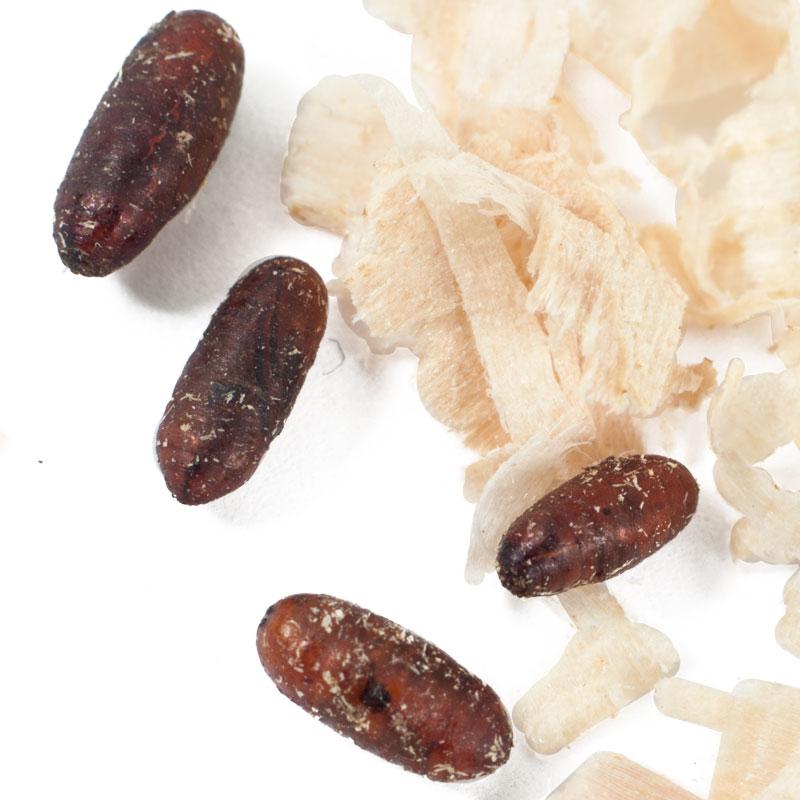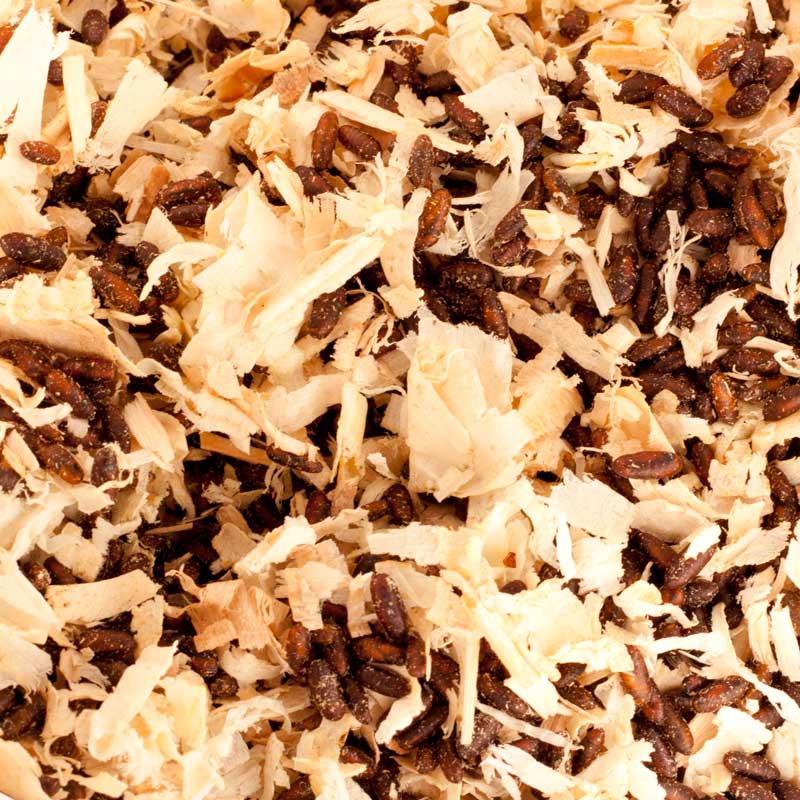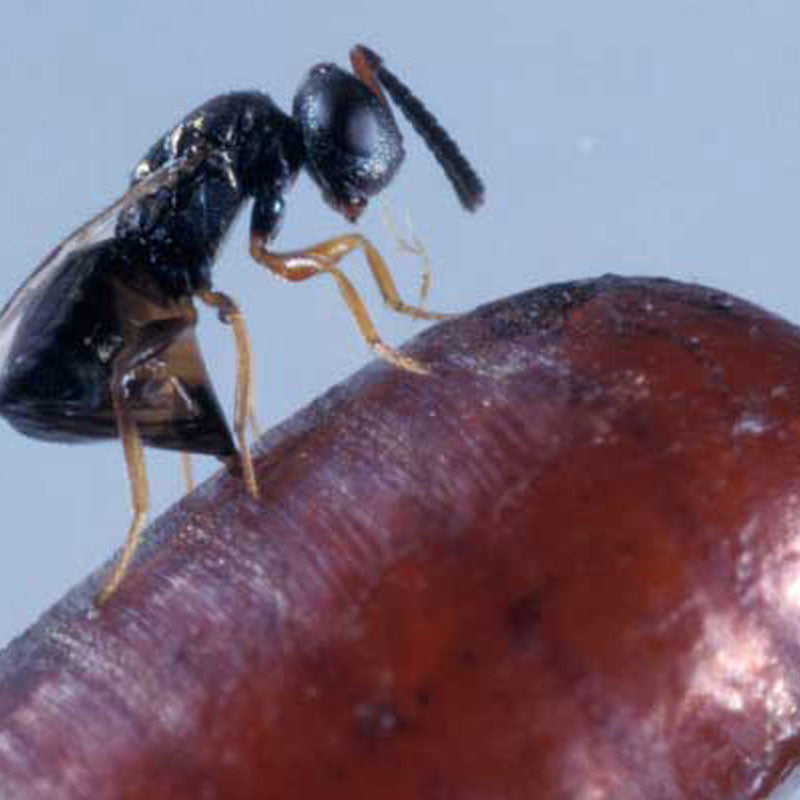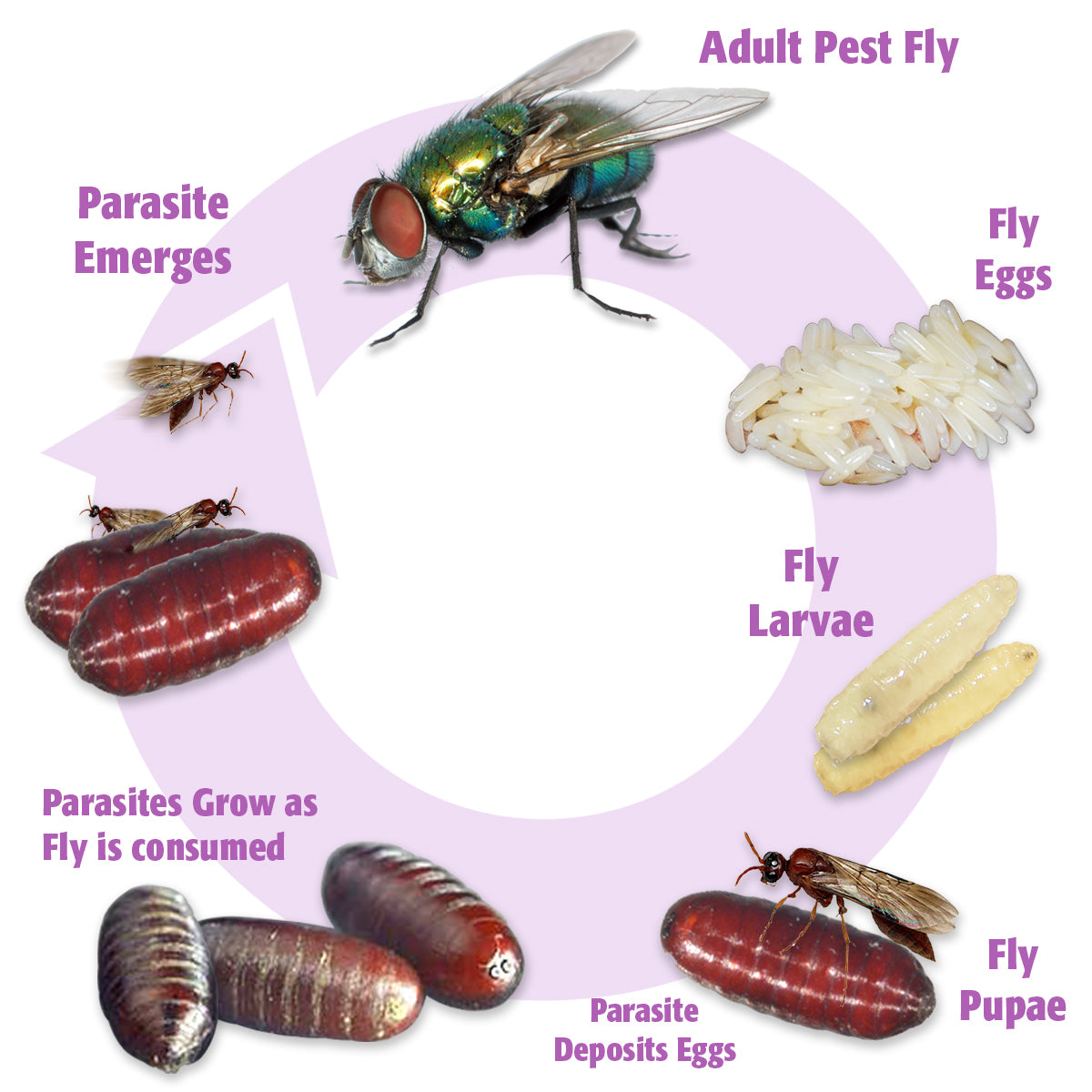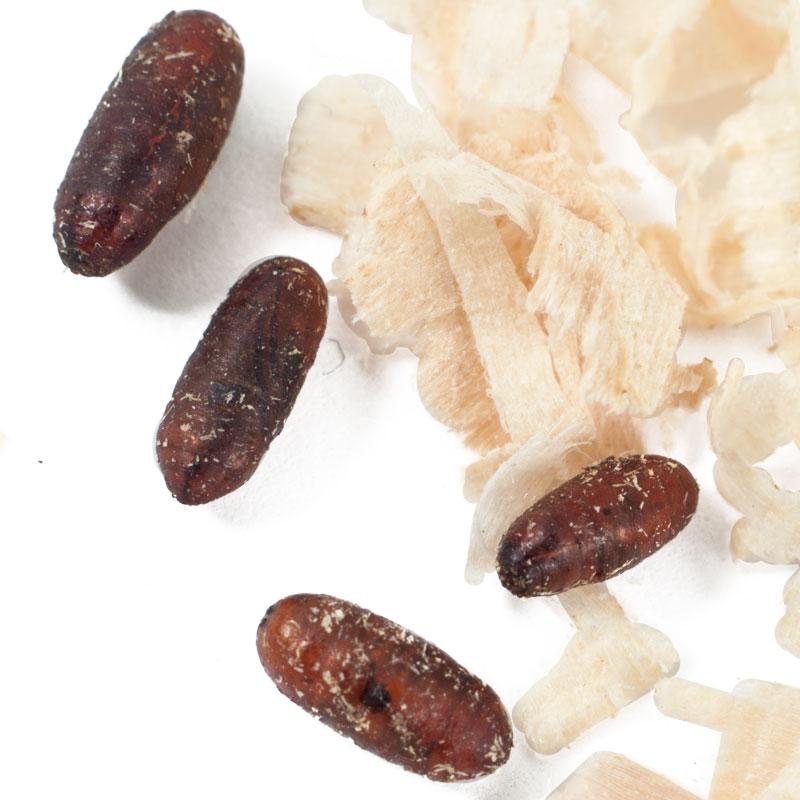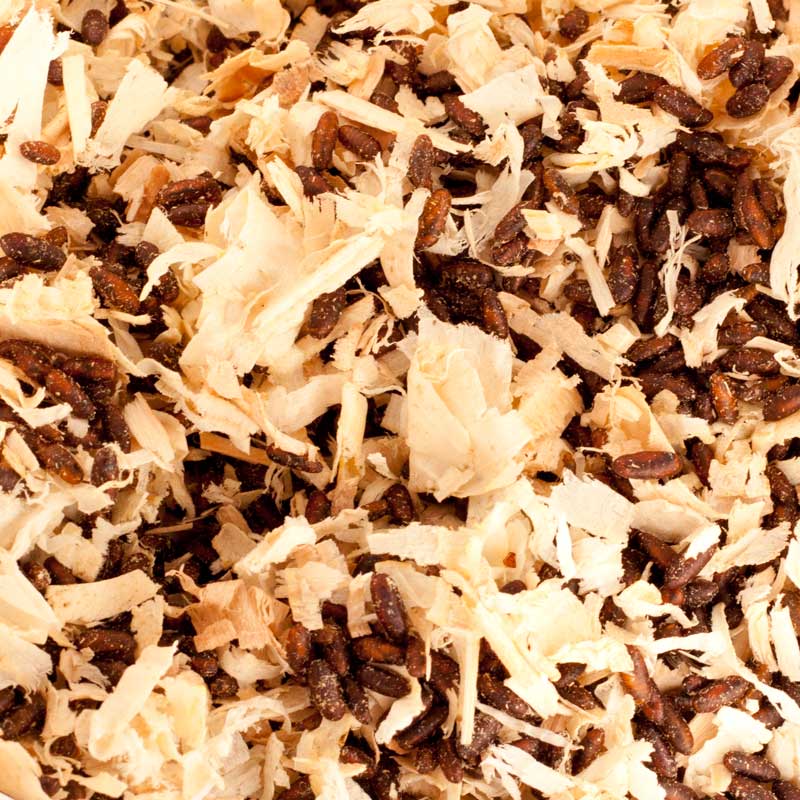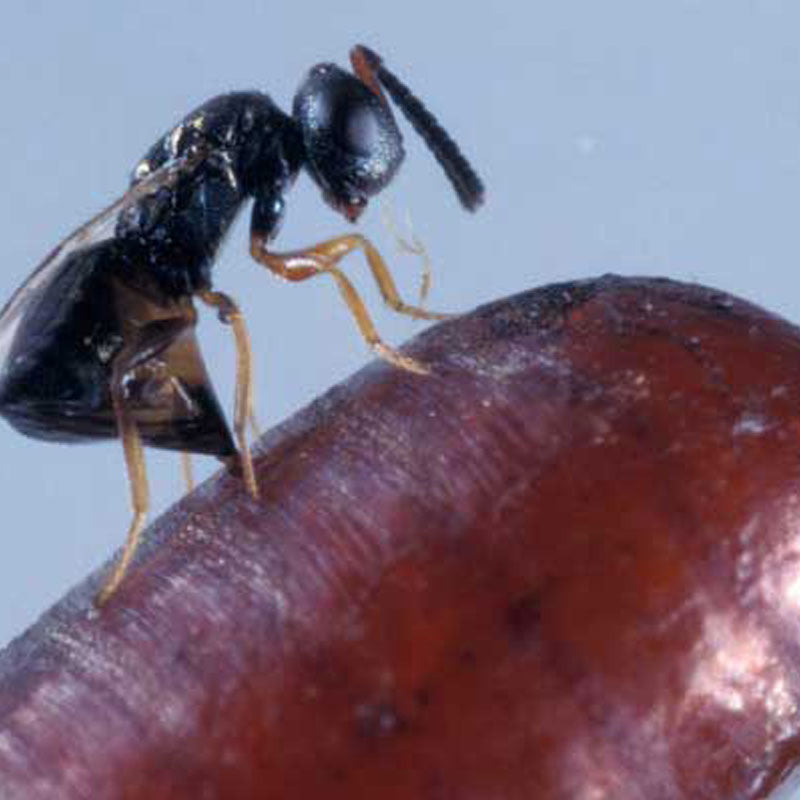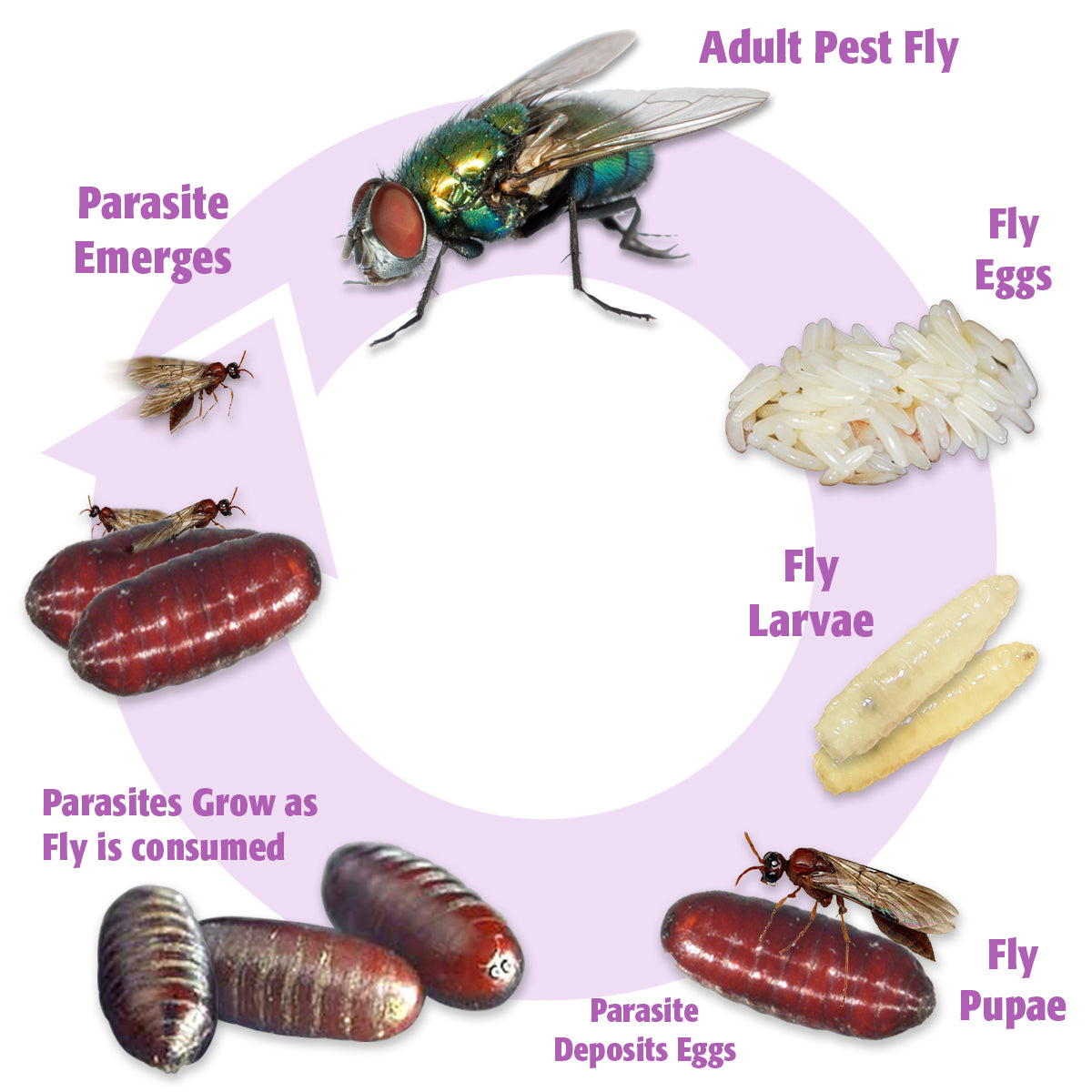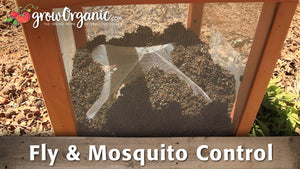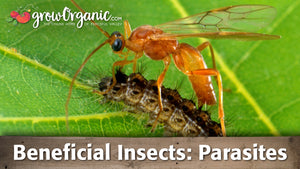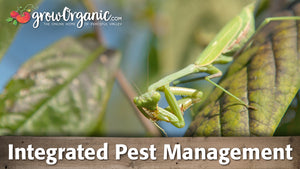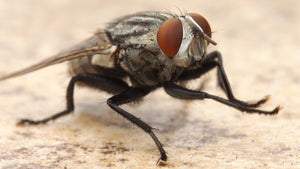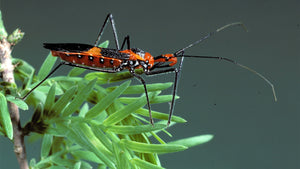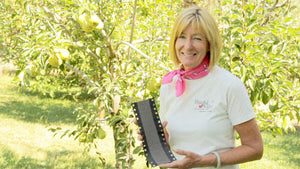Item Number: PBE250
Fly Parasite Complex (Unit Of 15,000)
Fly Parasite Complex (Unit Of 15,000)
Reduce Fly Populations with a Natural Predator
Price includes delivery via Priority Mail (US Postal Service) either to your mailbox, or to a Post Office box.
Insects are sent out Tuesday and Wednesday. Place your order at least 3 business days in advance of desired shipping date (Monday holidays will delay processing of order). Unless you specify otherwise, we will send your Beneficial Insects on the next possible shipping day. You could also request delayed delivery in the Order-Specific Comments box.
Muscidifurax raptorellus, Muscidifurax zaraptor, and Spalangia cameroni are tiny wasps that don't bother humans, but parasitize the pupae of many species of flies found in areas with livestock, breaking the life cycle of the flies.
You cannot place too many parasites. You can place too few. For dairies, feed lots and horse stables, we recommend between 300 and 500 parasites per animal per month during the fly season (March to October or November depending on weather). For confined hog operations, this number will be between 200 and 400 parasites per animal per month. Chickens require from 1 to 5 per bird per month. If your fly problem is very severe, these numbers should be increased; the first and second releases especially should be doubled or tripled.
- Begin release program as soon as the weather begins to warm up.
- Flies reproduce at a faster rate than the the fly parasites, so reintroduction on a regular basis is important.
- Release every 1- 4 weeks during all warm months, generally March or April (once temperature reaches 80°F) through October.
- For later starts, double the rates for the first 2 releases.
- Use in conjunction with PVF&GS Fly Trap for best results.
Using predatory wasps to control fly populations in farms and gardens is a fascinating and environmentally friendly approach to pest management. This method, part of an agricultural practice known as biological control, harnesses the natural predator-prey relationships to maintain pest populations at manageable levels.
The concept of biological control dates back to ancient times, but it wasn't until the late 19th and early 20th centuries that the practice began to gain scientific backing and widespread acceptance. One of the early successes of biological control was the introduction of the Vedalia beetle to control cottony cushion scale in California citrus orchards in the 1880s. This success paved the way for further exploration into using natural predators to control pests.
Predatory wasps, belonging to various species, play a significant role in controlling fly populations. These wasps are not the typical wasps that people generally fear; they are often smaller and less aggressive towards humans. Instead, they are formidable predators of various insect species, including flies.
There are different types of predatory wasps used in controlling flies. For example, some species of the genus Spalangia are known to parasitize fly pupae. These wasps lay their eggs inside the fly pupae, and the developing wasp larvae consume the pupae from the inside. Another example is the genus Muscidifurax, which also targets fly pupae. The use of these wasps is particularly prevalent in animal farms where flies can be a significant problem, spreading diseases and causing distress to livestock.
The introduction of predatory wasps into a farm or garden ecosystem is a delicate process. It requires a thorough understanding of the ecological balance and the life cycles of both the predator and the prey. The goal is to establish a sustainable population of wasps that can effectively control the fly population without causing harm to other beneficial insects or the overall ecological balance.
One of the significant advantages of using predatory wasps is the reduction in the need for chemical pesticides. Traditional fly control methods often involve the use of chemicals that can be harmful to the environment, beneficial insects, and even humans and livestock. Biological control, on the other hand, is a more sustainable and eco-friendly approach.
However, the effectiveness of predatory wasps can be influenced by various factors such as climate, the availability of prey, and the presence of other predators or competitors. Farmers and gardeners need to monitor the situation closely and may sometimes need to reintroduce wasps or adjust their strategies.
In recent years, the practice of using predatory wasps has gained popularity, particularly in organic farming, where the use of chemicals is limited. Research continues to evolve in this field, with scientists exploring the potential of different wasp species and developing methods to enhance their effectiveness and sustainability.
The use of predatory wasps in controlling fly populations represents a fascinating blend of ancient practices and modern scientific understanding. It exemplifies a shift towards more sustainable and environmentally friendly agricultural practices, highlighting the importance of understanding and working with natural ecosystems rather than against them.
Check Your Zone Compatibility:
Compatible with your zone.
Growing Zone for
,

Our Guarantee To You
Since 1976, we've served our customers at every stage of growing. Please contact us at any time. We are happy to support and assist you.
Description
Description
Price includes delivery via Priority Mail (US Postal Service) either to your mailbox, or to a Post Office box.
Insects are sent out Tuesday and Wednesday. Place your order at least 3 business days in advance of desired shipping date (Monday holidays will delay processing of order). Unless you specify otherwise, we will send your Beneficial Insects on the next possible shipping day. You could also request delayed delivery in the Order-Specific Comments box.
Muscidifurax raptorellus, Muscidifurax zaraptor, and Spalangia cameroni are tiny wasps that don't bother humans, but parasitize the pupae of many species of flies found in areas with livestock, breaking the life cycle of the flies.
You cannot place too many parasites. You can place too few. For dairies, feed lots and horse stables, we recommend between 300 and 500 parasites per animal per month during the fly season (March to October or November depending on weather). For confined hog operations, this number will be between 200 and 400 parasites per animal per month. Chickens require from 1 to 5 per bird per month. If your fly problem is very severe, these numbers should be increased; the first and second releases especially should be doubled or tripled.
- Begin release program as soon as the weather begins to warm up.
- Flies reproduce at a faster rate than the the fly parasites, so reintroduction on a regular basis is important.
- Release every 1- 4 weeks during all warm months, generally March or April (once temperature reaches 80°F) through October.
- For later starts, double the rates for the first 2 releases.
- Use in conjunction with PVF&GS Fly Trap for best results.
Using predatory wasps to control fly populations in farms and gardens is a fascinating and environmentally friendly approach to pest management. This method, part of an agricultural practice known as biological control, harnesses the natural predator-prey relationships to maintain pest populations at manageable levels.
The concept of biological control dates back to ancient times, but it wasn't until the late 19th and early 20th centuries that the practice began to gain scientific backing and widespread acceptance. One of the early successes of biological control was the introduction of the Vedalia beetle to control cottony cushion scale in California citrus orchards in the 1880s. This success paved the way for further exploration into using natural predators to control pests.
Predatory wasps, belonging to various species, play a significant role in controlling fly populations. These wasps are not the typical wasps that people generally fear; they are often smaller and less aggressive towards humans. Instead, they are formidable predators of various insect species, including flies.
There are different types of predatory wasps used in controlling flies. For example, some species of the genus Spalangia are known to parasitize fly pupae. These wasps lay their eggs inside the fly pupae, and the developing wasp larvae consume the pupae from the inside. Another example is the genus Muscidifurax, which also targets fly pupae. The use of these wasps is particularly prevalent in animal farms where flies can be a significant problem, spreading diseases and causing distress to livestock.
The introduction of predatory wasps into a farm or garden ecosystem is a delicate process. It requires a thorough understanding of the ecological balance and the life cycles of both the predator and the prey. The goal is to establish a sustainable population of wasps that can effectively control the fly population without causing harm to other beneficial insects or the overall ecological balance.
One of the significant advantages of using predatory wasps is the reduction in the need for chemical pesticides. Traditional fly control methods often involve the use of chemicals that can be harmful to the environment, beneficial insects, and even humans and livestock. Biological control, on the other hand, is a more sustainable and eco-friendly approach.
However, the effectiveness of predatory wasps can be influenced by various factors such as climate, the availability of prey, and the presence of other predators or competitors. Farmers and gardeners need to monitor the situation closely and may sometimes need to reintroduce wasps or adjust their strategies.
In recent years, the practice of using predatory wasps has gained popularity, particularly in organic farming, where the use of chemicals is limited. Research continues to evolve in this field, with scientists exploring the potential of different wasp species and developing methods to enhance their effectiveness and sustainability.
The use of predatory wasps in controlling fly populations represents a fascinating blend of ancient practices and modern scientific understanding. It exemplifies a shift towards more sustainable and environmentally friendly agricultural practices, highlighting the importance of understanding and working with natural ecosystems rather than against them.
Note: These creatures will die if left in direct sunlight or in a rural mailbox on a hot afternoon, or in cold weather. We only guarantee viability if someone accepts and inspects the insects immediately upon delivery. Be sure to open your box when you receive your order to prevent these beneficials from suffocating. You must contact us immediately upon delivery if you suspect a viability problem. Because of this, often the best address to use is a work address. If the Post Office is instructed to leave the package in a cool, safe place and it’s for a short period of time, viability should not be compromised, but cannot be guaranteed. If no one is available and no instructions have been left, delivery may be re-attempted the next business day. However, viability may be compromised and will not be guaranteed.
Fly parasites play a crucial role in nature's intricate food web. By parasitizing fly pupae, they help regulate fly populations, preventing outbreaks that can have detrimental effects on livestock, poultry, and even human health. Moreover, these tiny wasps contribute to the overall health and hygiene of ecosystems, reducing the need for chemical pesticides and promoting a more sustainable approach to pest control.
Life Cycle of Fly Parasites:
Understanding the life cycle of fly parasites is essential for their effective deployment in pest management:
Egg Laying: Female fly parasites seek out fly pupae in manure, decaying organic matter, or other suitable breeding sites. They deposit their eggs inside the pupae.
Parasitization: Once inside the pupa, the parasitic wasp larva feeds on the developing fly, ultimately causing its death.
Emergence: After completing their development, new adult fly parasites emerge from the fly pupae, ready to continue the cycle.
Effective Use of Fly Parasite Complex:
To maximize the benefits of the Fly Parasite Complex for fly control, consider the following tips:
Early Deployment: Release fly parasites early in the season to prevent fly populations from becoming established.
Regular Releases: Depending on the size of the area and the severity of the fly infestation, multiple releases of fly parasites may be necessary throughout the fly season.
Proper Placement: Distribute the fly parasites in areas where flies are known to breed, such as animal manure piles, compost heaps, or other suitable locations.
Temperature Considerations: Fly parasites are most effective in warm weather, so plan your releases accordingly.
Compatibility: Fly parasites are compatible with many other integrated pest management (IPM) strategies, making them a valuable addition to your pest control program.
Benefits of Using Fly Parasites:
Chemical-Free Pest Control: Fly parasites provide an environmentally friendly and chemical-free alternative to traditional fly control methods, reducing chemical exposure and promoting sustainable pest management.
Reduced Fly Populations: By targeting fly pupae, fly parasites help reduce adult fly populations, leading to a cleaner and healthier environment for both humans and animals.
Economic Savings: Employing fly parasites can result in cost savings by minimizing the need for costly fly control measures and treatments.
The Fly Parasite Complex exemplifies the power of harnessing nature's predators to combat persistent pests. These tiny parasitic wasps play a vital role in regulating fly populations, promoting ecological balance, and offering an eco-friendly alternative to chemical pesticides. By understanding their life cycle and deploying them strategically, you can effectively manage fly infestations while contributing to a more sustainable and harmonious environment. The Fly Parasite Complex is a valuable tool in the arsenal of eco-conscious pest control practices, enhancing the well-being of both agricultural and urban landscapes.
Read more about parasite flies here.
Shipping Information
Shipping Information
FREE SHIPPING via USPS Priority Mail to the lower 48 states.
Cannot ship to the following states: HI, PR, VI, GU
Ships directly from the vendor. Tracking emails will be sent once the box ships.
Shipping Weight: 1.0 lb
Dimensions: 0.0"L x 0.0"W x 0.0"H
Features
Features
Characteristics
Characteristics
Use Instructions
Use Instructions
Useful Information
Useful Information
Guarantee
Guarantee
Share
